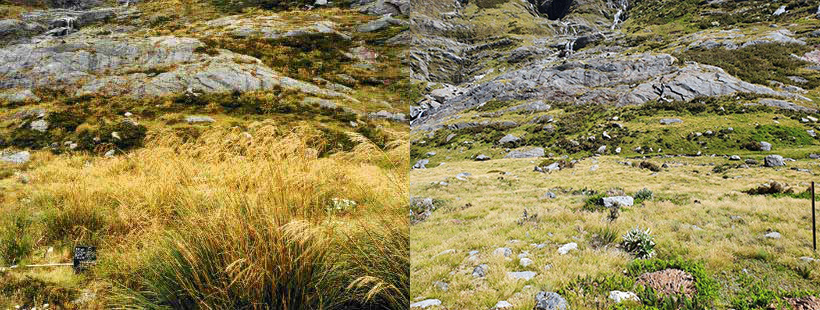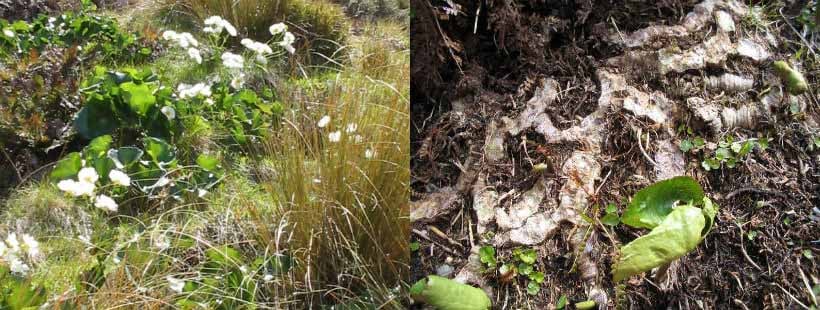Tahr and conservation
Introduction
Find out about Himalayan tahr and the importance of managing their population, the challenges they pose for conservation and how you can help.Himalayan tahr and chamois were introduced to New Zealand in the early days of European settlement for sport. Both animals have found the Southern Alps of the South Island ideal habitat, but have become a major threat to the ecosystems in these alpine areas.
About tahr
Himalayan tahr (Hemitragus jemlahicus) are large goat-like animals, native to the central Himalayan ranges of India and Nepal. In New Zealand tahr are found in the central Southern Alps between about the Rakaia and Whitcombe valleys in the north to about Lake Hawea in the south.
Tahr are generally found in the alpine grassland zone, where they graze on snow tussocks, alpine herbs and sub-alpine shrubland plants.
Tahr are remarkably fast and agile in steep and rugged terrain. Their hooves are designed for surefootedness, with a combination of hard and soft surfaces to give excellent grip.
The male tahr’s summer coat is a reddish-brown, females a medium brown, both turning dark brown in winter. The bull tahr has an impressive mane of long hair around the neck and shoulders.
Tahr are popular with recreational and tourist hunters. Their horns and the male's striking mane are sought-after trophies.
Tahr are social animals and form easily recognisable groups. Adult females, juveniles and kids gather together. Mature males over four years form bachelor groups, and younger males hang out together in separate, smaller groups. Males mix in with the females in their range over the winter breeding season but during the summer months they often travel long distances away from the female groups.
The impact of tahr
As tahr have no natural predators in New Zealand their population can increase unchecked, unless there is regular control from hunters or DOC. Large groups can form and damage plants which provide vital food and shelter for native animals.
Threat to native plants
 Zora Canyon, Landsborough in 1999 (left) and 2020 (right) showing the impact of tahr
Zora Canyon, Landsborough in 1999 (left) and 2020 (right) showing the impact of tahr
Image: DOC
New Zealand alpine ecosystems evolved over millions of years in isolation without any large mammal browsers (such as tahr), and many alpine plants have no defence mechanisms (such as toxins or spines) to discourage tahr from eating them.
Herding browsers such as tahr and chamois cause two-fold damage; firstly, by eating native plants; secondly by trampling large areas of vegetation and compactable soils, when herds of animals gather together.
Tahr graze at high altitudes, in alpine grasslands and sub-alpine shrublands, and browse on native plants that birds, lizards and insects use for feeding, nesting and shelter. The tahr diet includes some large, succulent herbaceous species including alpine buttercups and mountain daisies. Some of these species are ranked as Threatened or At Risk by the New Zealand Threat Classification System.
Tahr also feed on snow tussock and shrub species which are the dominant vegetation in many of New Zealand’s subalpine and alpine environments. Tahr are a major threat to the sensitive ecosystems of alpine regions as their social nature increases pressure in localised areas. In extreme situations, large groups of tahr can transform tall tussocks and subalpine shrublands to a grassy turf or bare ground.

Tahr damage to the Mount Cook lily – before (left) and after (right)
Image: DOC
Threats to native animals
The changes tahr can cause to the alpine and sub-alpine plant communities affect the native animals that live there by reducing their access to food and shelter. Over time, they may disappear from these sites.
This is because rare native birds, such as kea and rock wren, may no longer find enough shelter or food. Tahr may also be directly competing with threatened alpine scree wētā, since both animals feed on alpine buttercups.
DOC's work
Monitoring is undertaken to follow trends in the tahr population and to understand the impacts of tahr on the alpine environment, both of which help inform management actions.
Assessing the impact
DOC has been recording the impacts of Himalayan tahr on alpine and subalpine biodiversity since the early 1990s by monitoring a network of 117 permanent plots in alpine grasslands within the tahr management units.
New research since 2011 has established that there is less shrub cover in the tahr management areas than in the tahr exclusion zones (the areas to the north and south of the tahr feral range). Research published in 2017 found that tahr browse reduced native tussock grassland height at some monitored plots between 1990 and 2013.
High tahr numbers have led to a drastic change in the vegetation around the Makaawhio River, South Westland, with tall snow tussocks in some places almost gone.
Reports on impacts of Himalayan tahr
- Long-term impacts of an introduced ungulate in native grasslands: Himalayan tahr in New Zealand’s Southern Alps (PDF, 801K)
- Impact of Himalayan tahr on snow tussocks in the Southern Alps, New Zealand (2014) (PDF, 964K)
- Impact of Himalayan tahr on snow tussock grasslands in the Southern Alps (2004) (PDF, 12,131K)
- Potential of Tier 1 and alternative monitoring networks to assess the ecological integrity of alpine vegetation exposed to tahr grazing (PDF, 3,999K)
Population monitoring
Aerial surveys have been carried out over recent years to estimate the density and abundance of Himalayan tahr on public conservation land in each of the seven management units and two exclusion zones in the Southern Alps. A factsheet describing the surveys, their findings and how the contribute to management is provided below, along with the individual reports from each set of surveys.
From 2016 to 2019, 117 plots were surveyed by helicopter to provide an initial estimate of the tahr population on public conservation land (PCL) across the core of their range and two ‘Exclusion Zones’ (seven tahr ‘Management Units’ (MU) and two ‘Exclusion Zones’ are defined by the Himalayan Thar Control Plan 1993). The total abundance of tahr on PCL within that range for the period 2016–2019 was estimated to be between 26,522 and 44,821 (a mean of 34,478; Ramsey and Forsyth, 2019).
In early 2021, 43 plots were surveyed across MU 1 (South Rakaia and Upper Rangitata) and MU 3 (Gammack/Two Thumb), two of the most accessible and popular tahr hunting areas. 2016-19 survey plots were re-surveyed and additional plots were added to provide better data for the MU areas (cf. the overall population). The total abundance of tahr in MU1 in 2021 was estimated to be between 4,740 and 9150 (a mean of 6,600). In MU3 it was estimated to be between 6,200 and 14,150 (a mean of 9,350; Ramsey and Forsyth, 2021).
In early 2023, 43 plots were surveyed across the 7 MUs. These were a randomly selected sub-set of the initial 117 plots (surveyed in 2016-2019), designed as a streamlined process to give an estimate of the overall population on PCL across the 7 MUs within resource constraints. The total abundance of tahr within the MUs in 2023 was estimated to be between 22,100 and 40,150 (a mean of 29,800; Ramsey, 2023).
Population monitoring reports
- Factsheet: Monitoring Himalayan tahr populations in New Zealand (PDF, 668K)
- Abundance of Himalayan tahr on public conservation land in New Zealand – results from the 2023 aerial survey (PDF, 996K)
- Abundance of Himalayan tahr in the South Rakaia/Upper Rangitata and Gammack/Two Thumb Management Units (2021) (PDF, 1,168K)
- Factsheet: Estimating Himalayan tahr numbers in New Zealand (PDF, 886K)
- Estimates of Himalayan tahr abundance in New Zealand September 2019 (PDF, 1,741K)
- Estimates of Himalayan tahr abundance in New Zealand 2015-2018 (PDF, 1220K)
Managing tahr numbers
Wildlife populations are inherently difficult to accurately count. Tahr are particularly challenging as they inhabit rugged and remote terrain and they aggregate, meaning you can find substantial numbers of tahr in small areas and no tahr across large areas. The methods used to estimate tahr populations can account for some of those issues but still provide population estimates with large ranges. This means that management actions need to account for substantial uncertainty.
DOC's management of tahr is guided by the Himalayan Thar Control Plan 1993 and the Himalayan Thar Management Policy 1991. The Himalayan Thar Control Plan 1993 is prepared under the Wild Animal Control Act 1977, and guides DOC’s annual Tahr Control Operational Plans. The annual plans are designed to manage tahr in areas throughout the feral range where they remain at high densities, to control any tahr outside the feral range, and to move the overall tahr population towards goals of the 1993 plan.
The Policy and Plan allow for a managed population of up to 10,000 tahr across Crown pastoral leases, private land and public conservation land to co-exist with our native species.
There are very few tahr in the exclusion zones, as all tahr present in these areas are targeted for removal to prevent the tahr feral range from expanding.
The population estimates outlined above suggest that the overall tahr population has likely decreased slightly between 2019 and 2023. It is likely that overall decrease is underpinned by a decrease in the remaining tahr population’s ability to reproduce, as most DOC tahr control has preferentially targeted female and young animals (leaving identifiable males for hunters).
Tahr control operations has more information about current and recent management activity.
You can help
If you see tahr in areas outside their feral range (PDF, 306K), let the local DOC office know.
Hunters play a pivotal role in helping to manage tahr numbers and protect our alpine ecosystems.
Take part in a hunt – you will have a great outdoor adventure and contribute to keeping tahr or chamois numbers down. Just make sure you have your hunting permit.
Find tahr hunting ‘hotspots’
DOC is mapping the locations of tahr observed on public conservation land.
Use our tahr sightings maps to plan hunts on conservation land, or find areas where you can hunt tahr and other wild animals.
